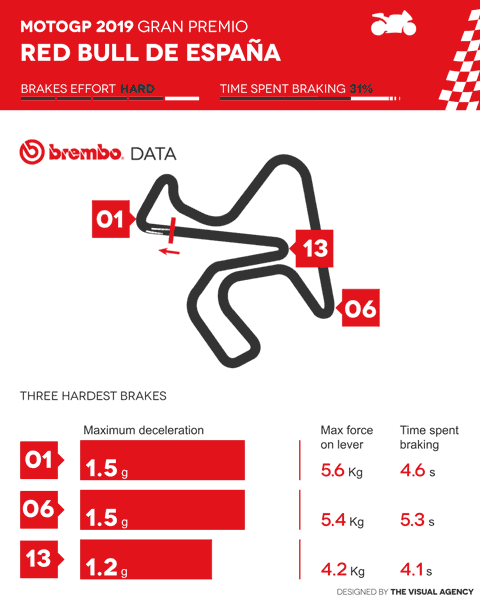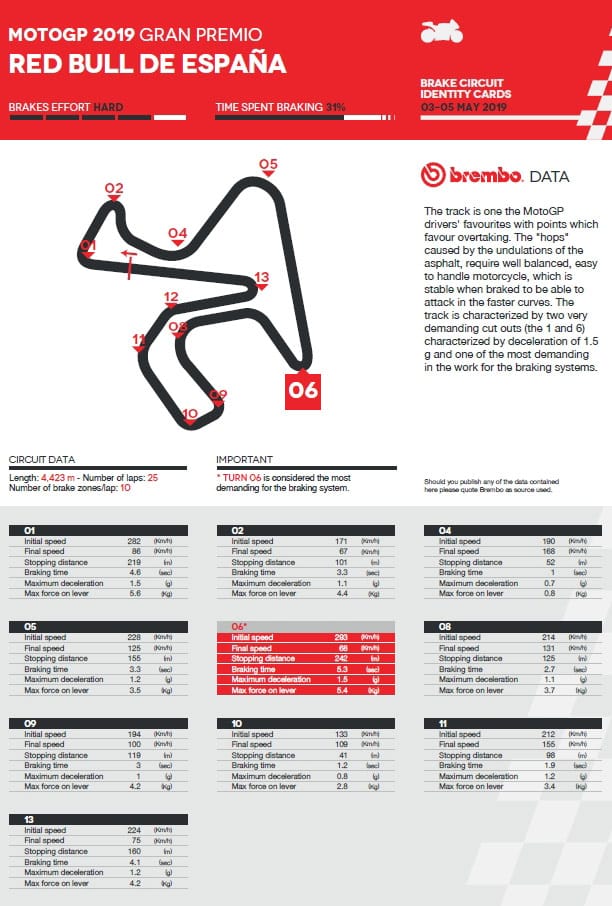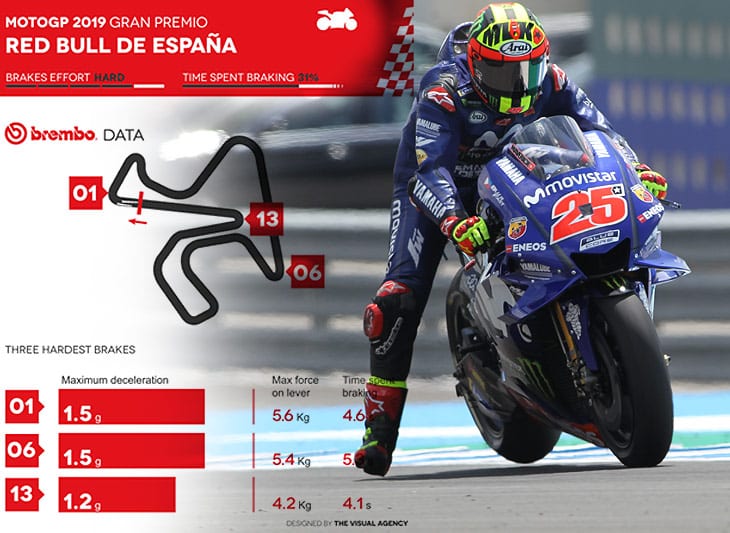With the 3 non-European rounds completed, MotoGP heads to Spain for the 4th round of the 2019 season, which will take place from May 3 to 5 at the Circuito de Jerez. Inaugurated on December 8, 1985, this circuit has hosted the premier category since 1987. However, in 1988, the race was qualified as the Portuguese GP because the Spanish GP took place in Jarama.
In 1992, it became the first track in the championship to replace straw bales with air protection. The 4 meters of the track alternate between slow, fast and very fast turns. The 423 turns (13 right and 8 left) make up 5% of the total length and provide plenty of places to pass. Significant changes in slope require a motorcycle that handles well and is well balanced, in addition to being stable under braking.
This year again, 100% of the motorcycles participating in the MotoGP championship are equipped with Brembo brakes and Brembo engineers have assigned a brake difficulty index to each circuit on the calendar: according to the Brembo engineers who assist all MotoGP riders, the Circuito from Jerez is the most demanding track of the first third of the season in terms of braking, that is to say on the first 6 Grands Prix. On a scale of 1 to 5, it scored a 4 on the difficulty index, the same score as Aragón and Brno.
The demand on the brakes during the GP
Each lap, drivers will have to use the brakes 10 times for a total of 30 seconds. In absolute terms, this is not excessively high, especially when compared to the 37 seconds per lap at Austin and the 39 seconds at Sepang. However, on these two tracks, the records range from 1'59" to 2'04", while in Jerez the times are 1'38".
The presence of 2 moderate braking sections, that is to say with less than 25 km/h drop in speed, results in an average deceleration during racing of only 1,13 G. The values of 0,7 G at turn 4, and 0,8 G at turn 10 decrease this average.
If we add up all the force applied by the rider on the Brembo brake lever from the start line to the checkered flag, the value is over 950 kg, a value that Losail also achieves. Concretely, on each lap, the driver must apply a force of 38 kg.

The most demanding braking sections
Of the 10 braking zones at the Circuito de Jerez, 2 are classified as demanding on the brakes and 5 are of medium difficulty. The other 3 have a low impact on the braking systems.
The most complicated braking section is in the sixth turn (Dry Sack). The drivers start braking at 293 km/h and only complete the operation after 5,3 seconds, during which they cover 242 meters.
To descend to 68 km/h, they apply a load of 5,4 kg to the brake lever and experience a maximum deceleration of 1,5 G.
Braking operations at the first corner (Expo 92) are also quite difficult. MotoGP bikes go from 282 km/h to 86 km/h in 219 meters and 4,6 seconds. However, the load on the lever (5,6 kg) is higher, as is the Brembo HTC 64T brake fluid pressure (11,9 bar) and the deceleration is 1,5 G, or 0,3 G of more than the 200 km/h to 0 of a Porsche 993 Turbo.
Also note the 9,4 bars of the braking system at the second corner. MotoGP bikes brake for 3,3 seconds to enter the corner at 67 km/h, but the deceleration is only 1,1 G.
Brembo Performance
Brembo brakes have won 28 of the 40 editions of the Spanish GP, including the last 25. Yamaha has won 2 of the last 4 editions, but Honda has won no less than 18 with Brembo brakes. This year, Valentino Rossi continues his 10th victory at Jerez. He won in 1997 in the 125 category, in 1999 in the 250 category, in 2001 in the 500 category and 6 times in MotoGP. Every time he won he used Brembo brakes.





